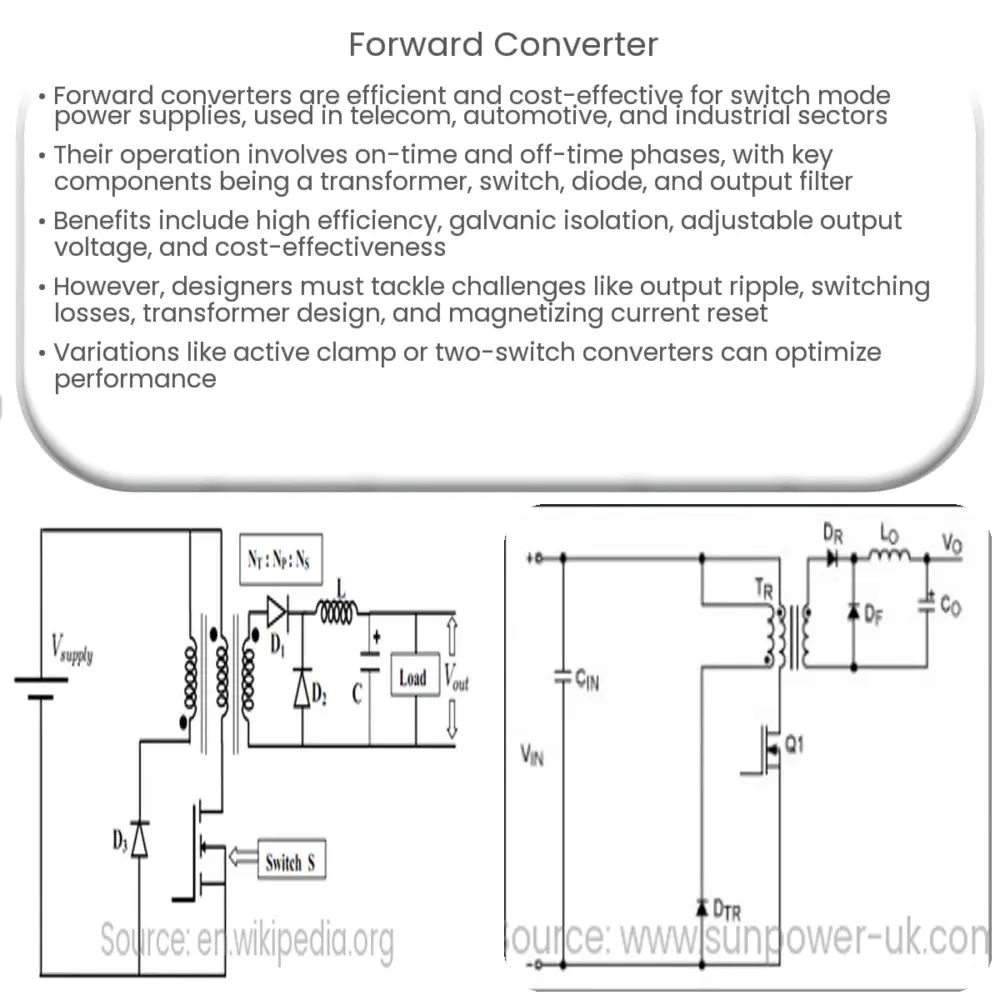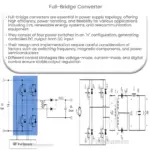Explore the forward converter, a popular SMPS topology known for its efficiency, simplicity, and versatility in various applications.

Understanding the Forward Converter: A Deep Dive
The forward converter is a popular topology used in switch mode power supplies (SMPS) for its efficiency, simplicity, and cost-effectiveness. It has a wide range of applications, including telecommunications, automotive, and industrial sectors, thanks to its ability to handle a variety of input voltages and power levels. In this article, we will explore the principles behind forward converters, their operation, and benefits.
Basics of the Forward Converter
At its core, the forward converter is a type of buck-derived converter, which means that it steps down voltage from a higher level to a lower level. It achieves this by employing a transformer, providing both galvanic isolation and an adjustable voltage conversion ratio. The main components of a forward converter include a transformer, a switch (typically a MOSFET), a diode, and an output inductor-capacitor (LC) filter.
Operating Principle
The operation of a forward converter can be divided into two phases: the on-time and the off-time.
On-time
During the on-time, the switch (MOSFET) is turned on, and the input voltage is applied to the primary winding of the transformer. This generates a magnetic field in the transformer’s core, storing energy. Simultaneously, the voltage induced in the secondary winding forward-biases the output diode, allowing current to flow through the output inductor and charging the output capacitor, which supplies the load.
Off-time
When the switch is turned off, the magnetic field in the transformer starts to collapse, and the voltage across the primary winding reverses polarity. The diode connected in series with the primary winding (often referred to as the “freewheeling diode”) becomes forward-biased, providing a path for the magnetizing current to flow, thus resetting the transformer’s core. On the secondary side, the output diode becomes reverse-biased, and the energy stored in the output inductor continues to supply the load through the output capacitor.
Benefits of Forward Converters
There are several advantages to using forward converters in power supply designs, which include:
- Efficiency: Due to the use of a transformer, forward converters can achieve high efficiency, typically in the range of 85-95%, depending on the design and load conditions.
- Galvanic Isolation: The presence of a transformer offers galvanic isolation between the input and output, providing safety and noise immunity for sensitive loads.
- Voltage Scaling: The turns ratio of the transformer can be adjusted to provide a wide range of output voltage options.
- Cost-effectiveness: Forward converters are relatively simple and require fewer components compared to other topologies, making them more cost-effective in many applications.
Limitations and Challenges
Despite the many benefits of forward converters, there are also some limitations and challenges that designers should consider:
- Output Ripple: Forward converters inherently produce output voltage ripple due to the switching action. Proper filtering and design considerations are necessary to minimize this ripple and ensure stable output.
- Switching Losses: The hard switching of the MOSFET in forward converters can lead to increased losses, especially at higher frequencies. Soft-switching techniques can be employed to reduce these losses and improve efficiency.
- Magnetizing Current Reset: Ensuring proper reset of the transformer’s core magnetizing current is crucial for stable operation. This may require the use of an additional winding or an RCD snubber circuit to provide a reset path for the magnetizing current.
- Transformer Design: Designing the transformer for optimal performance in a forward converter can be challenging, as it must balance efficiency, size, and cost considerations.
Improvements and Variations
Over the years, several variations and improvements have been introduced to the basic forward converter topology to enhance its performance and overcome its limitations:
- Active Clamp Forward Converter: This topology uses an active clamp circuit to reset the transformer’s core and reduce voltage stress on the switch, improving efficiency and reliability.
- Two-Switch Forward Converter: By adding a second switch, this topology minimizes the voltage stress on the primary switches, improving efficiency and allowing for higher input voltage operation.
- Synchronous Rectification: Replacing the output diode with a synchronous MOSFET can significantly reduce conduction losses, further improving efficiency, especially at higher output currents.
Conclusion
Forward converters are a versatile and efficient solution for a wide range of switch mode power supply applications. While they do have some limitations, careful design choices and the use of advanced topologies can help to overcome these challenges. By understanding the principles, operation, and benefits of forward converters, designers can create optimized power supplies that deliver high performance, reliability, and cost-effectiveness.



